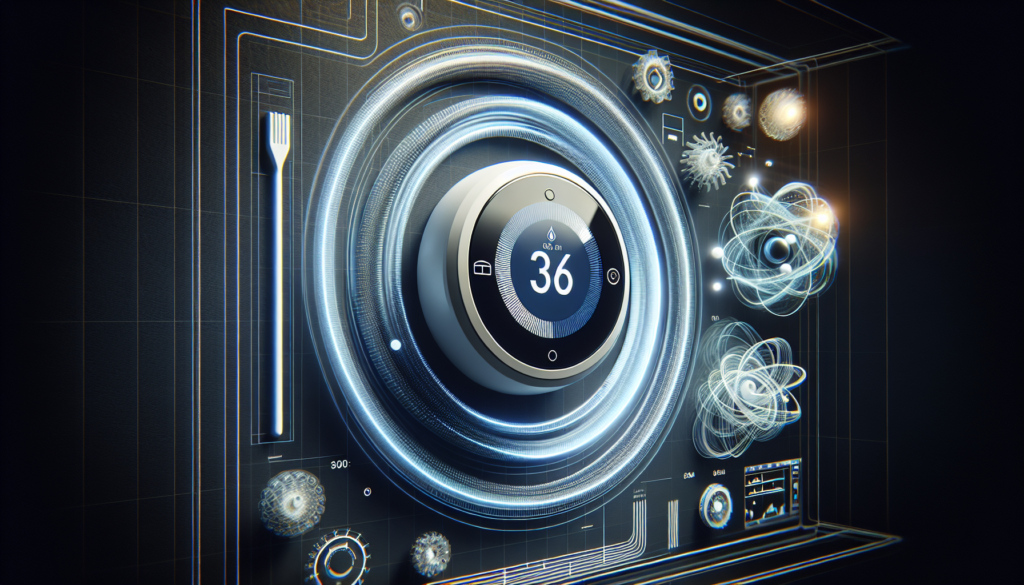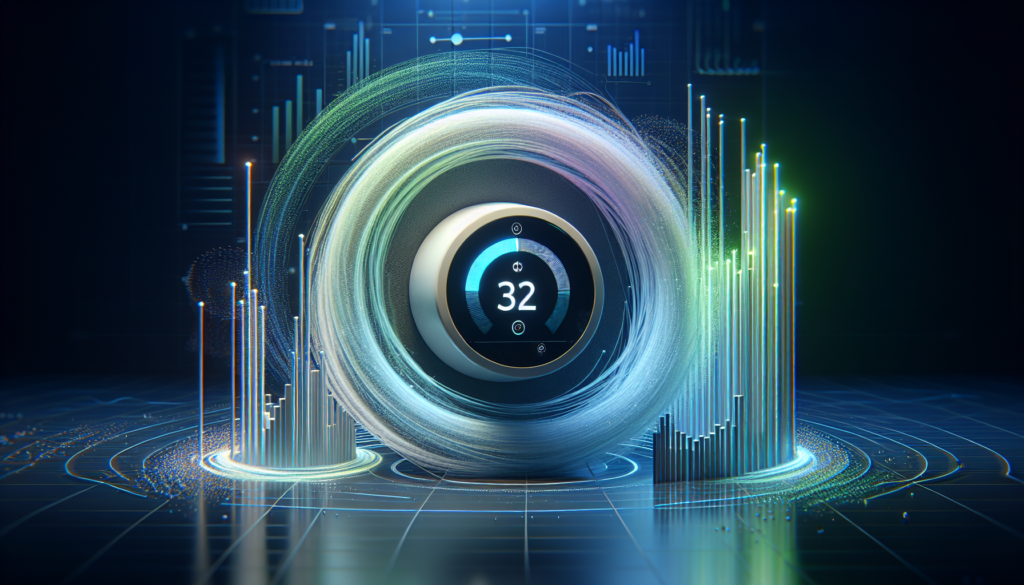Curious about how much energy your smart thermostat is using? Wondering if you can easily access detailed reports and data about your energy consumption? The answer is yes! With a smart thermostat, you have the power to stay informed about your energy usage and make informed decisions to save both energy and money. In this article, we will explore how you can access energy usage data and reports with your smart thermostat, giving you the knowledge you need to optimize your home’s energy efficiency.

Understanding Smart Thermostats
How do smart thermostats work?
Smart thermostats are innovative devices that allow you to have greater control over your home’s heating and cooling systems. Unlike traditional thermostats, smart thermostats come equipped with built-in sensors, Wi-Fi connectivity, and advanced algorithms that make them capable of automatically adjusting the temperature based on your preferences and energy-saving settings.
These devices can learn your daily schedule and temperature preferences, adapting to your routines to ensure optimal comfort while minimizing energy wastage. Some smart thermostats even have geofencing capabilities, which means they can detect when you’re away from home and adjust the temperature accordingly to save energy.
What are the benefits of using a smart thermostat?
The benefits of using a smart thermostat are numerous. Firstly, they give you the ability to control and monitor your home’s temperature remotely using your smartphone or computer. This feature allows you to adjust the temperature while you’re away, ensuring comfort upon your return without wasting energy when no one is home.
Secondly, smart thermostats provide energy usage data and reports that give you insights into your home’s energy consumption patterns. By understanding how and when you use energy, you can make more informed decisions about how to optimize energy usage, resulting in potential cost savings and reduced environmental impact.
Additionally, these devices often come with energy-saving features such as scheduling and learning algorithms that can help you conserve energy and lower your utility bills. Overall, smart thermostats offer convenience, energy savings, and greater control over your home’s climate.
Accessing Energy Usage Data
Can I access energy usage data with my smart thermostat?
Yes, accessing energy usage data is one of the key features of smart thermostats. These devices collect real-time data on your home’s energy consumption and provide you with detailed reports and insights to help you understand your energy usage patterns.
How is energy usage data collected and displayed?
Smart thermostats collect energy usage data through their built-in sensors and algorithms. They monitor factors such as temperature, occupancy, and weather conditions to track how much energy is being used to heat or cool your home. This data is then displayed in user-friendly formats, such as graphs or charts, which make it easy for you to analyze and interpret your energy consumption patterns.
What information is usually provided in energy usage reports?
Energy usage reports generated by smart thermostats typically include information such as daily and monthly energy consumption, average temperature settings, runtime durations, and cost estimations. Some reports may also break down energy usage by specific HVAC equipment or provide comparisons with previous periods to help you track your progress in reducing energy consumption.

Integration with Energy Monitoring Platforms
Can my smart thermostat integrate with energy monitoring platforms?
Yes, many smart thermostats can integrate with energy monitoring platforms. These platforms provide advanced analytics and additional insights into your energy usage, allowing you to have a more comprehensive understanding of your home’s energy consumption.
What are the advantages of integrating with an energy monitoring platform?
Integrating your smart thermostat with an energy monitoring platform offers several advantages. Firstly, it expands the range of data available to you, giving you a more detailed view of your energy consumption patterns. This can help you identify hidden energy inefficiencies and pinpoint areas for improvement.
Secondly, energy monitoring platforms often offer personalized recommendations and tips on how to optimize your energy usage. These recommendations can range from simple adjustments to your thermostat settings to suggestions for upgrading your home’s insulation or HVAC equipment for better energy efficiency.
Furthermore, integrating with an energy monitoring platform may also provide access to additional features, such as real-time energy tracking, energy usage goal setting, or even energy usage comparisons with similar homes in your area.
How is the integration process typically carried out?
The integration process varies depending on the specific smart thermostat and energy monitoring platform you choose. In most cases, it involves linking your smart thermostat account with the energy monitoring platform through the respective mobile app or web portal. Some smart thermostats may have built-in integrations with popular energy monitoring platforms, while others may require you to manually input API keys or credentials to establish the connection.
Once the integration is set up, your smart thermostat will sync its energy usage data with the energy monitoring platform, allowing you to access all the additional features and insights provided by the platform.
Using Mobile Apps and Web Portals
Can I access energy usage data through a mobile app or web portal?
Yes, accessing energy usage data through mobile apps and web portals is a common feature offered by smart thermostat manufacturers. These platforms provide a convenient way for you to monitor and control your thermostat remotely from your smartphone, tablet, or computer.
What features are available in mobile apps and web portals?
Mobile apps and web portals for smart thermostats offer a wide range of features that go beyond just accessing energy usage data. These platforms allow you to view and adjust temperature settings, create schedules, set energy-saving preferences, and receive alerts or notifications regarding your thermostat’s status or energy usage.
Some apps and portals even provide more advanced features, such as energy usage breakdowns by specific timeframes or categories, options to compare your energy consumption with others in your area, and access to energy-saving tips and recommendations.
Can I control my thermostat remotely through these platforms?
Yes, one of the main advantages of using mobile apps and web portals with smart thermostats is the ability to control your thermostat remotely. As long as you have an internet connection, you can adjust the temperature settings, change temperature modes, or even turn your thermostat on or off from anywhere in the world. This feature ensures that you can always have a comfortable home environment while minimizing energy wastage when you’re away.

Real-Time Energy Monitoring
Is real-time energy monitoring possible with a smart thermostat?
Yes, real-time energy monitoring is possible with some smart thermostats, depending on the model and manufacturer. Real-time energy monitoring allows you to see your home’s energy consumption at any given moment, giving you immediate feedback on how your energy usage is affected by temperature changes or adjustments to your thermostat settings.
What equipment or sensors are required for real-time monitoring?
In most cases, smart thermostats that offer real-time energy monitoring do not require any additional equipment or sensors beyond their built-in capabilities. These thermostats are equipped with advanced sensors that can accurately measure and monitor your home’s power usage without the need for additional hardware.
Can I receive notifications or alerts regarding my energy usage?
Yes, many smart thermostats offer the ability to receive notifications or alerts regarding your energy usage. These notifications can be triggered by specific events, such as significant changes in energy consumption, excessive energy usage, or reminders to adjust your thermostat settings for optimal energy efficiency. By receiving these alerts, you can stay informed about your energy usage patterns and take appropriate action to reduce energy wastage.
Analyzing Energy Usage Patterns
Can my smart thermostat analyze energy usage patterns?
Yes, smart thermostats are designed to analyze your energy usage patterns. By monitoring factors such as temperature settings, occupancy, and weather conditions, these devices can generate insights into how and when your home consumes energy.
What insights can be gained from analyzing energy consumption patterns?
Analyzing energy consumption patterns can provide valuable insights into your home’s energy usage behavior. For example, you might discover that adjusting the temperature by a few degrees during certain times of the day can result in significant energy savings. You may also identify patterns that indicate unnecessary energy wastage, such as consistently running your HVAC system when no one is home.
By understanding these insights, you can make more informed decisions about how to adjust your thermostat settings, create energy-saving schedules, or even make home improvements to enhance energy efficiency.
Are there any recommendations provided for optimizing energy usage?
Many smart thermostats offer personalized recommendations for optimizing energy usage based on your energy consumption patterns. These recommendations can range from simple adjustments, such as adjusting temperature settings during certain hours, to more advanced suggestions, such as upgrading insulation or HVAC equipment.
By following these recommendations, you can optimize your energy usage and potentially reduce your utility bills while maintaining a comfortable home environment.

Historical Usage Reports
Can my smart thermostat generate historical energy usage reports?
Yes, smart thermostats have the capability to generate historical energy usage reports. These reports provide a detailed overview of your energy consumption over a specific period, allowing you to track trends, identify changes in usage, and monitor the effectiveness of any energy-saving measures you have implemented.
How far back can I access historical usage data?
The availability of historical usage data varies depending on the smart thermostat model and manufacturer. Some devices may provide access to several months’ worth of historical data, while others may offer a shorter time frame. It is important to consult the product specifications or documentation to understand the specific capabilities of your smart thermostat in terms of historical data access.
What formats are these reports available in?
The formats of historical energy usage reports depend on the smart thermostat and the accompanying software or app. Typically, these reports are available in user-friendly formats, such as graphs or charts, that make it easy to visualize and understand your energy consumption patterns. Some reports may also provide detailed breakdowns of energy usage by specific timeframes, days of the week, or even specific HVAC equipment.
Data Privacy and Security
How is my energy usage data protected?
Smart thermostat manufacturers understand the importance of data privacy and take measures to protect your energy usage data. They typically employ industry-standard encryption protocols to ensure that your data is secure when it is transmitted between your smart thermostat and any connected devices or platforms.
Who has access to my energy usage data?
Access to your energy usage data is typically limited to you as the device owner and anyone you choose to grant access to. Smart thermostat manufacturers have strict privacy policies and only collect and use your data for the purposes outlined in their terms of service. It is important to review the privacy policy of your specific smart thermostat to understand how your data is handled.
What measures are in place to safeguard privacy and prevent data breaches?
Smart thermostat manufacturers have implemented various measures to safeguard privacy and prevent data breaches. This includes encryption of data during transmission, secure storage of data on servers, regular security audits, and compliance with relevant data protection regulations. Additionally, manufacturers often provide regular firmware updates to their devices, which helps to address any known security vulnerabilities and ensures that your smart thermostat is protected against potential threats.

Comparing Smart Thermostat Models
Do all smart thermostats offer energy usage data access?
While many smart thermostats offer energy usage data access, it is not a universal feature across all models. It is important to compare the features and specifications of different smart thermostats to determine which ones provide the specific energy monitoring capabilities you are looking for. Manufacturers usually highlight energy usage data access as one of the key features, so it should be relatively easy to identify if a particular smart thermostat offers this functionality.
What are the differences in energy monitoring features among different models?
The differences in energy monitoring features among different smart thermostat models can vary significantly. Some models may only provide basic energy usage data, such as daily or monthly consumption totals, while others may offer more detailed breakdowns, comparisons, or additional analytics. It is important to review the product specifications or consult product reviews to understand the specific energy monitoring features offered by different smart thermostat models.
Are there any third-party devices or services needed to access energy usage data?
In most cases, smart thermostats do not require any third-party devices or services to access energy usage data. The data is typically collected and stored directly by the smart thermostat itself or transmitted to a companion app or web portal provided by the manufacturer. However, if you choose to integrate your smart thermostat with an energy monitoring platform or other third-party services, it may require additional devices or software to establish the connection.
Tips for Maximizing Energy Efficiency
How can I use the energy usage data to make my home more energy-efficient?
Using the energy usage data provided by your smart thermostat, you can make informed decisions to maximize energy efficiency in your home. By analyzing the usage patterns and identifying areas of energy wastage, you can adjust your thermostat settings or create energy-saving schedules that align with your daily routines. For example, you could program your thermostat to lower the temperature during hours when nobody is home or while you are sleeping.
Additionally, you can identify any patterns or trends in your energy consumption and take steps to address them. For instance, if you notice consistently high energy usage during certain times of the day, you may want to investigate possible causes, such as inefficient appliances or HVAC system issues.
Are there any additional tips for reducing energy consumption?
In addition to utilizing the energy usage data provided by your smart thermostat, here are some additional tips for reducing energy consumption:
Ensure your home is well-insulated: Proper insulation helps to maintain a comfortable indoor temperature and reduces the workload on your HVAC system.
Upgrade to energy-efficient appliances: Energy-efficient appliances consume less electricity and can result in significant energy savings over time.
Use natural lighting and efficient lighting fixtures: Optimize natural light whenever possible and replace traditional incandescent bulbs with energy-efficient LED or CFL bulbs.
Unplug or power down electronics when not in use: Many electronics consume “standby power” even when turned off. Unplugging or using power strips with switches can help eliminate this wasted energy.
Set energy-saving preferences on other devices: Beyond your smart thermostat, consider adjusting energy-saving settings on other devices, such as your computer, television, or gaming console, to reduce their energy consumption.
Can I set energy usage goals or targets with a smart thermostat?
Some smart thermostats offer the ability to set energy usage goals or targets. These features allow you to establish specific energy consumption objectives or targets to strive for. By monitoring your progress towards these goals and making adjustments to your thermostat settings or energy usage habits, you can work towards optimizing energy efficiency and reducing your environmental footprint.
In conclusion, smart thermostats provide a range of benefits to homeowners, including the ability to access energy usage data and reports. They offer insights into energy consumption patterns, integrate with energy monitoring platforms, and provide features such as real-time energy monitoring and historical usage reports. By using the data and insights provided by smart thermostats, homeowners can make informed decisions to optimize energy usage, maximize energy efficiency, and reduce utility bills.










